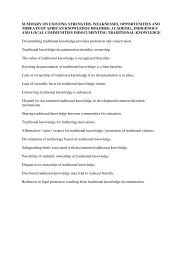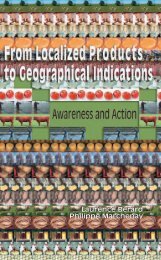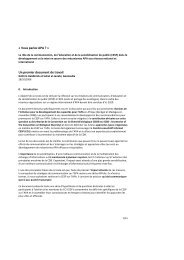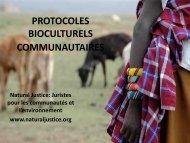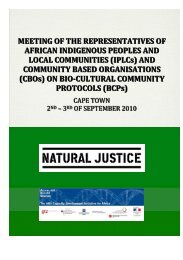The History of Farmers' Rights - Fridtjof Nansens Institutt
The History of Farmers' Rights - Fridtjof Nansens Institutt
The History of Farmers' Rights - Fridtjof Nansens Institutt
Create successful ePaper yourself
Turn your PDF publications into a flip-book with our unique Google optimized e-Paper software.
34 Regine Andersen<br />
M. Geetha Rani explores how community gene banks can be developed<br />
as a means to sustain food security and to put farmers’ rights into practice.<br />
<strong>The</strong> author points to experiences with community gene banks in<br />
India and Ethiopia, but stresses that the success <strong>of</strong> community gene banks<br />
is heavily dependent on national legal frameworks.<br />
***<br />
Srinivasan, C.S. (2003) ‘Exploring the Feasibility <strong>of</strong> Farmers’ <strong>Rights</strong>’,<br />
Development Policy Review, Vol. 21, No. 4, pp. 419–447<br />
This article examines the feasibility <strong>of</strong> farmers’ rights provisions based<br />
on intellectual property rights. It argues that the farmers’ rights legislation<br />
already adopted in some developing countries will involve enormous<br />
operational difficulties, while intellectual property rights based farmers’<br />
rights are unlikely to provide any significant economic returns to farmers<br />
or farming communities. Indeed, they may dilute the incentives for innovation<br />
provided to institutional plant breeders, the author argues, noting<br />
that this may not be a desirable outcome for developing countries.<br />
Conservation projects supported by community gene funds may be a better<br />
way to address concerns regarding the conservation <strong>of</strong> agrobiodiversity,<br />
but it would be unrealistic to expect that such funds could be financed<br />
through levies on the royalties <strong>of</strong> plant breeders, the author concludes.<br />
***<br />
Borowiak, C. (2004): ‘Farmers’ <strong>Rights</strong>: Intellectual Property Regimes<br />
and the Struggle over Seeds’, Politics & Society, Vol. 32, No. 4, pp.<br />
511–543.<br />
This article analyses farmers’ rights as a strategy <strong>of</strong> resistance against the<br />
perceived inequities <strong>of</strong> intellectual property rights regimes for plant genetic<br />
resources. Borowiak finds that farmers’ rights are a unique form <strong>of</strong><br />
rights that may help to transform intellectual property rights systems in<br />
ways better suited for registering and encouraging alternative forms <strong>of</strong><br />
innovations, particularly farmers’ innovations. However, thus far it has<br />
been difficult to enact farmers’ rights. <strong>The</strong> author concludes that by situating<br />
farmers’ rights alongside easily enacted commercial breeders’<br />
rights, the endeavour risks further legitimizing the inequities it is responding<br />
to.<br />
***<br />
Brush, Stephen B. (2004): ‘<strong>Rights</strong> over Genetic Resources and the<br />
Demise <strong>of</strong> the Biological Commons’, pp. 219–255 in Stephen B.<br />
Brush: Farmers’ Bounty. Locating Crop Diversity in the Contemporary<br />
World (New Haven, CT and London: Yale University Press).<br />
Stephen B. Brush contrasts the common heritage principle with intellectual<br />
property rights over plants and shows how the genetic commons are<br />
being closed. He highlights how the emerging situation cannot be described<br />
solely as a ‘tragedy <strong>of</strong> the commons’ (see Brush, 2005 above) but<br />
also as a ‘tragedy <strong>of</strong> the anti-commons’, where multiple owners have the






